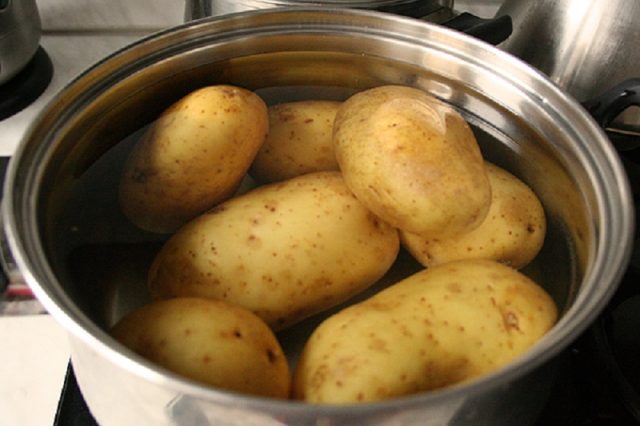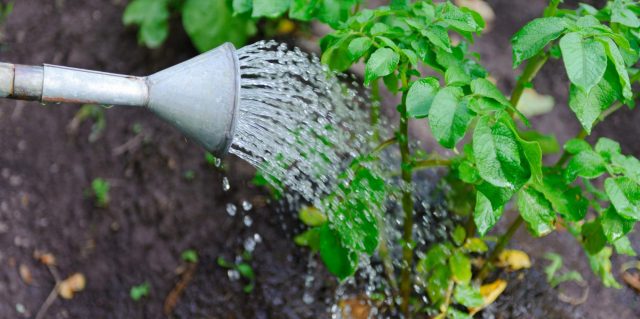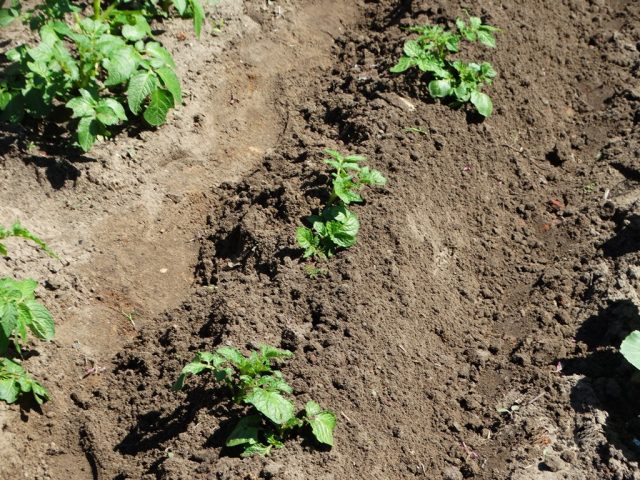Content
- 1 Wendy's Potato Description
- 2 Taste qualities of potatoes
- 3 Pros and cons of Wendy's potato variety
- 4 Planting and caring for Wendy's potatoes
- 5 Landing rules
- 6 Watering and feeding
- 7 Loosening and weeding
- 8 Hilling
- 9 Diseases and pests
- 10 Potato yield
- 11 Harvesting and storage
- 12 Conclusion
- 13 Wendy's potato reviews
Wendy's potatoes are a mid-season table variety. It is intended for cultivation both on individual household plots and in the conditions of industrial areas of large agricultural companies. Since the tubers lend themselves well to mechanical cleaning, the variety is widely used in the large-scale production of potato products.
Wendy's Potato Description
The variety was developed in Germany. In its selection, the popular Gala potato was used as a basis. The originator of the variety was Norika Nordring. In 2014, the crop was entered into the State Register of Breeding Achievements of the Russian Federation, with the admission of cultivation in the Central region of Russia (Tula, Ryazan, Kaluga, Vladimir, Bryansk, Ivanovo, Moscow, Smolensk regions).
Distinctive characteristics of the Wendy potato variety are excellent presentation, high yield, accelerated adaptation and large tubers. Wendy is highly resistant to nightshade diseases. It lends itself well to mechanical harvesting.
Potato plants are stem type, medium height. Bushes grow upright, moderately spreading. The leaves of the variety are large, light green in color. The corolla of potatoes is medium-small, the color of the plant is white.
The Wendy variety has a well-developed root system. In one nest, you can find 6 - 11 oval tubers with yellow skin. The eyes are small and shallow. The harvested potatoes weigh 90 - 120 g.
Taste qualities of potatoes
Wendy's potatoes taste good. The cultivar belongs to the cultivated type B. Its flesh is quite dense in structure. After heat treatment, when cutting, the tubers do not significantly change their color. From a culinary point of view, the variety is classified as universal, suitable for use in the preparation of various dishes. Wendy's potatoes can be fried, boiled, and baked. It is also well suited for making soups and salads.
Pros and cons of Wendy's potato variety
Like any crop, the Wendy variety has its own advantages and disadvantages.
The pluses include:
- Low starch content;
- High indicators of vitamin and mineral composition: the variety is suitable for use as a product of the dietary group;
- Ripe potatoes have a regular round shape, which greatly simplifies harvesting, especially by a mechanical method;
- The skin of root crops is dense, which protects it from damage during long-term transportation or storage;
- The variety shows a high yield.
The disadvantages of the Wendy variety include:
- Dependence on watering: should constantly monitor the level of moisture in the ground;
- The Wendy variety is characterized by a slow emergence of seedlings.
Planting and caring for Wendy's potatoes
Caring for the Wendy variety has several nuances. To harvest a large harvest, you must adhere to the rules of soil preparation, planting, watering, feeding, disease prevention.
Selection and preparation of the landing site
Sandy loam is the ideal place to plant Wendy's potatoes. It is also important that the soil contains a sufficient amount of fertilizer.To ensure easy formation of young fruits, potatoes need a light soil. When growing in heavy soil, the yield can be significantly lower, the tubers will have an irregular shape, which will increase the amount of waste. If the planting site has a soil with a heavy structure, it must be diluted with river sand.
Preparation of planting material
Before proceeding with the planting of planting material, it must be placed in a warm room for 24 hours, with sufficient access to sunlight. This will allow the skin of the potato to harden, which will further promote good growth of the plant.
In addition, direct sunlight makes it possible to disinfect the inoculum from bacteria and harmful microorganisms. It is necessary to plant those tubers, the sprouts of which have reached the size of at least one centimeter. It is better not to use tubers with too long sprouts: because of their fragility, they are unsuitable for planting.
Landing rules
To achieve the optimal quality of the Wendy potato crop, you should follow the rules of agricultural technology:
- Use tubers of standard sizes: deviations from the standard should not exceed 5 cm.
- Until the period when the soil is covered with tops, the planting must be mulched.
- To ensure uniform illumination, the landing should be positioned in the direction from north to south.
- Adhere to the recommended planting scheme: for Wendy's potatoes, the distance between the beds should be 40 cm, with a distance between the bushes of about 50 cm.
- The planting depth depends on the type of soil: on light soils it should be from 10 to 12 cm, on heavy loamy soils - from 8 to 10 cm, on heavy clay soils - from 4 to 5 cm.
- Avoid thickening in cases where planting was not carried out using fine planting material.
Watering and feeding
For the Wendy variety, watering is required at least three times during the season. At the same time, the frequency of precipitation and soil moisture are taken into account. It is better to water the plants in the morning or evening. When watering, a point approach is used, that is, the delivery of water to each bush. It is also convenient because it is possible to selectively regulate the watering of specific bushes.
Each bush should be supplied with a maximum of 4 liters of water, which should flow to the roots in portions, 1 liter per nest. So, after the watered bush has completely absorbed moisture, another liter of water is added to it. This can be done with a bucket or watering can, but it is optimal to use a hose with a spray at the end (this will help prevent soil erosion). After the top layer of soil is poured, passing one row, they move to another, after watering which they return to the first row and repeat the procedure.
As a top dressing, the potatoes are sprinkled with wood ash after planting.
Loosening and weeding
Since the roots of the plant need constant access to oxygen, a week after planting, you need to loosen the soil near the bushes. The procedure will need to be repeated if an earthen crust appears around the plants.
Hilling
Hilling Wendy's potatoes is necessary for active growth. The event allows you to protect the bushes from temperature drops. This is especially true for areas with low air temperatures.
After the sprouts reach 10 cm, the first hilling can be performed. The second is carried out after the plants have risen 45 cm in height. It is necessary to form a hill of soil around each bush.The best time to complete the procedure is in the morning or evening after watering.
Diseases and pests
The main problem of the Wendy variety is rhizoctonia. The following diseases are not terrible for potatoes:
- Scab;
- Late blight;
- Viral infections.
The plant shows an average resistance:
- To the nematode;
- Twisting of sheet plates;
- Potato crayfish;
- Late blight tops.
The Wendy variety is neutral to the Colorado potato beetle. As protection against insects, plants must be treated with a special compound. Usually they use insecticide preparations Colorado, Aktara, Killer, Euphoria. As a naturally available remedy against the Colorado potato beetle, dill is planted between the potato beds.
For the prevention of diseases, the quality of feedings is monitored. Basic root dressing:
- Bird droppings - in the grooves between the beds, in a solution with water 1:10, respectively;
- Urea - at the root, before the first hilling, half a liter of solution per bush: dilute a tablespoon in 10 liters of water, pre-loosen the kidney;
- Mullein - between rows: a liter of manure per bucket of water;
- Herbal infusion - along the perimeter of the hole, without touching the stem: from any weeds, soaking and fermenting them in water, then diluting until the color of light tea; it is best used in the evening in June when the nitrogen demand of plants is high.
- Mineral dressing, solutions (20 g per 10 liters of water): ammonium nitrate; a mixture of nitrogen, phosphorus and potassium fertilizers in a ratio of 1: 1: 2.
Potato yield
Wendy is a high yielding variety. If you follow all the rules of planting and care, you can get up to 700 quintals of potatoes from one hectare. At the same time, one bush gives up to 25 fruits. If we take into account the mass of one root crop, it is easy to calculate that the yield from one bush will be about 2.5 kg.
Harvesting and storage
From the moment the first shoots appear until the harvest of potatoes, it takes about 70 - 80 days. If you do not take into account the automated method, then there are two ways to collect Wendy's potatoes:
- Pitchfork. It is best to use a pitchfork to reduce the risk of tuber damage and the need for leveling the ground.
- If you dig potatoes with a shovel, then there is a high risk of damage to the tubers. During periods when the soil is too dry, it is best to use this particular tool.
To increase the shelf life of tubers, the tops of the plants must be removed a week before harvest. You can store potatoes both in boxes and in bags: in the darkest place, ideally in cellars, in conditions of lower temperatures.
Conclusion
Wendy's potatoes are a very good variety for home use. The potato has excellent taste characteristics. When planted and cared for correctly, the Wendy variety will provide a large yield.












